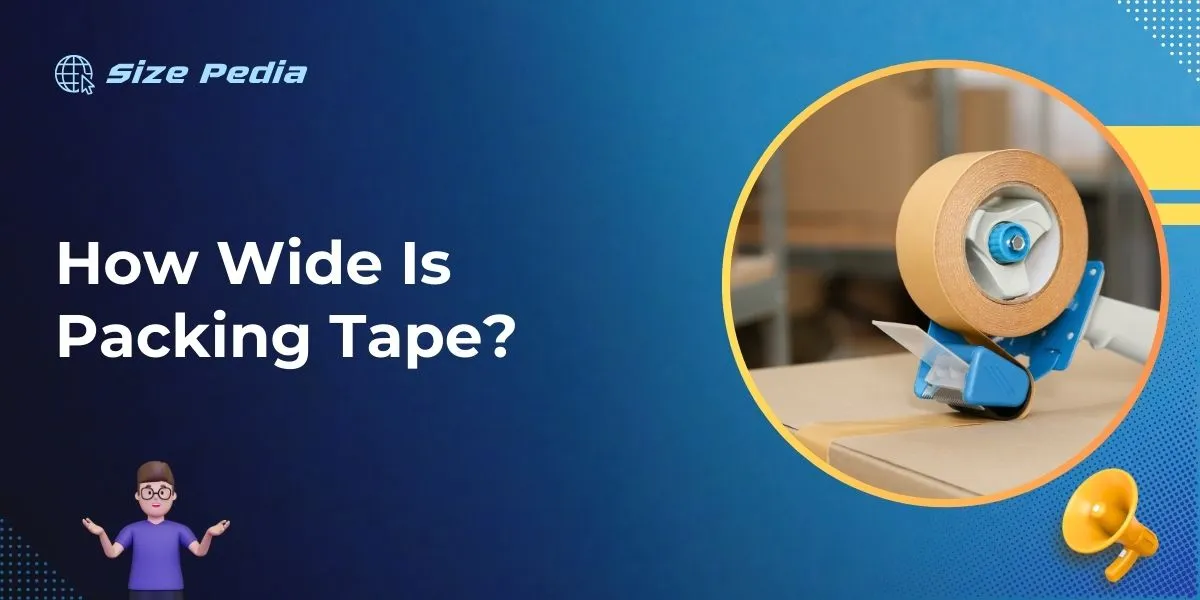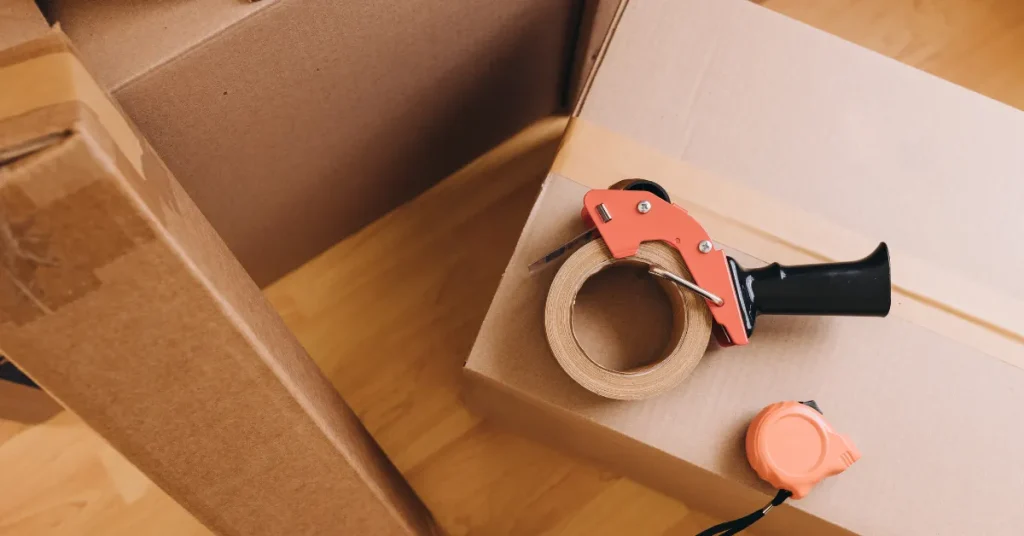Packing tape typically measures about 2 inches in width. Its standard size makes it ideal for sealing boxes.
Packing tape is an essential tool in both the moving and storage industries, as well as for general home use.
The width of 2 inches (approximately 48mm to 50mm) ensures it provides enough coverage to securely seal cardboard boxes and packages, preventing them from opening during transport or storage.
Available in various lengths and thicknesses, packing tape is designed to withstand different levels of handling and protect package contents. Its clear or brown color options allow for a professional look and compatibility with most packaging aesthetics.
Consumers often choose packing tape for its durability, strong adhesive properties, and ease of use with dispensers and tape guns, making it a ubiquitous presence in packing supply stores and online retailers.

The Role Of Packing Tape In Securing Packages
Imagine sending a gift to a friend far away. You want it to be a surprise. You want it to be safe. Packing tape makes this happen. It keeps your boxes shut tight.
No matter how far they travel. The tape’s width is key. It decides how strong the seal will be. Let’s dive into why tape is so important for packages.
Fundamentals Of Package Security
Keeping a package secure starts with the right tape. More than just making a box close, it stops things from falling out. A tight seal matters. It keeps things clean. It stops people from peeking inside.
Tape width works like a safety belt for your items. Wider tape means more coverage. More coverage means a better hold. A standard width is about two inches. Some tapes might be wider for heavier boxes. Proper taping ensures safe travels for your package.
Material Strength And Durability
Packing tape is strong. It needs to be. Boxes go through a lot. They are tossed around. They stack up. They slide. Tape holds them together through all this. Different tapes have different strengths.
Some are for light envelopes. Others are for big, heavy boxes. The tape’s material decides how tough it is. Polypropylene is common.
It’s clear and sticks well. There are also stronger ones. Like fiberglass-reinforced tape. This one is extra tough. It’s made for heavy-duty jobs.
| Tape Type | Material | Common Usage |
| Polypropylene | Plastic | Everyday packages |
| Fiberglass Reinforced | Plastic + Fiberglass | Heavy boxes |
- Seal with a single strip along the box’s edge.
- Overlap the tape for added strength.
- Use enough tape that it does not come loose.
- Select the right tape for your package weight.
- Apply the tape evenly on all box seams.
- Make sure the tape adheres well without gaps.
Remember these points and you’ll ensure your package remains secure from your hands to its final destination!
Common Widths Of Packing Tape And Their Uses
Understanding the various widths of packing tape ensures the right hold for parcels and boxes. Tape width affects its strength and suitability for different tasks. Choose wisely to secure items effectively.
Narrow Tapes For Small Boxes
Small boxes benefit from narrow packing tapes. Their width typically ranges from 0.75 to 1.5 inches (19 to 38 mm). This size is perfect for lightweight items and helps:
- Seal small to medium boxes
- Manage minor repairs
- Bundle documents or small items
Wide Tapes For Industrial Packaging
For larger, heavier shipments, wide tapes are key. They come in sizes from 2 to 3 inches (50 to 76 mm). Wide tapes offer:
- Extra strength for securing heavy items
- Better holding power on cardboard
- Efficiency in application, requiring fewer strips
| Tape Width | Common Uses |
| 0.75 – 1.5 inches | Small parcels, gift wrapping, minor repairs |
| 2 inches | Standard shipping boxes, moving boxes |
| 3 inches | Industrial packing, heavy-duty boxes |
Key Factors Influencing Packing Tape Width Selection

Picking the right width for packing tape can make all the difference. It’s about matching the tape to the job. Different tasks need different tapes. Think about the box size and weight. Think about what’s inside. This guide dives deep into choosing the best tape width like a pro.
Assessing Package Dimensions
Begin by measuring the box size. A wider tape may be overkill for small boxes. Use a measuring tape or ruler to get the length, width, and height of the box. Here’s a quick reference:
- Small packages: go for 1.88 to 2 inches wide.
- Medium boxes: 2 to 3 inches will usually do.
- Large items: consider tape up to 3 inches wide or more.
Considerations For Weight And Content Safety
Tape width also ties to the package’s weight. A heavy box needs strong support. Wider tape often offers this. It helps keep items safe inside. Think about these points:
| Package Weight | Recommended Tape Width |
| Under 40 pounds | 2 inches |
| 40-70 pounds | 2 to 3 inches |
| Over 70 pounds | 3 inches or more |
For delicate items, secure them with extra care. Layer the tape across all seams. This adds protection. It keeps the content safe from bumps and drops.
Measuring And Cutting Packing Tape Effectively
Measuring and Cutting Packing Tape Effectively ensures that packages are secured tightly, with no wasted material.
Whether you are preparing a parcel for shipping or storing goods, knowing the precise width and length of your packing tape can make the process more efficient and cost-effective.
Let’s dive into the best tools for measurement and the techniques for a flawless cut of your packing tape.
Tools For Accurate Tape Measurement
Finding the right tools helps you measure packing tape easily. A tape measure is a go-to gadget for many.
But for accuracy, consider using a ruler or measuring tape specifically designed for smaller widths. Digital calipers can also provide precise measurements. Here is a list of tools:
- Tape Measure
- Ruler
- Calipers
- Measuring Mat
Techniques For A Clean Cut
A clean cut is crucial for effective tape application. Scissors work well but can cause jagged edges. The best option is a dispenser with a sharp, built-in cutting blade. Follow these simple steps for a sharp cut of your packing tape:
- Extend the tape to your desired length.
- Hold the dispenser at a 45-degree angle.
- Press down firmly and slice across quickly.
For repeated use, consider a benchtop dispenser. This tool allows multiple pieces to be cut at the same length.
Enhancing Package Integrity With Proper Tape Application
Packing tape width can make or break your package integrity. Proper application ensures your item stays secure during handling and transit. Let’s delve into how to use packing tape effectively to keep your packages intact.
Strategic Tape Placement On Boxes
Strategic tape placement reinforces boxes where they need it most. Here’s how:
- Seal the center seam – the primary strip along the box’s join.
- Edge reinforcement – apply tape on box edges to combat wear.
- Tab coverage – fix loose flaps with additional tape.
The Impact Of Tape Overlap And Tension
Correct tape overlap and tension fortify your package:
- Overlap by at least half an inch – this guarantees no weak spots.
- Maintain uniform tension – to prevent tape from twisting or lifting.
| Tape Length | Overlap Amount | Tension Level |
| 2-3 inches longer than box width | At least 0.5 inches | Uniform across length |
Innovations In Packing Tape: Eco-friendly And Smart Options

The world of packing tape is evolving. Traditional options no longer reign supreme as innovations pave the way for smarter, more sustainable choices.
With global focus shifting towards environmentally friendly solutions, packing tape has undergone a significant transformation.
Beyond width and adhesive strength, consumers now consider the ecological footprint of their choices. This movement has given rise to eco-friendly and smart options in the packing tape market.
Sustainable Packing Tape Alternatives
Earth-conscious consumers celebrate the advent of sustainable packing tape. These alternatives promise minimal environmental impact while maintaining the strength needed for secure packages. Features include:
- Biodegradable materials: Tapes made with plant-based, compostable adhesives.
- Recycled content: Using recycled plastics or paper assures less waste.
- Reusable designs: Tapes that encourage multiple uses cut down on waste.
| Material | Features | Eco-Benefits |
| Plant-based | Biodegradable, Compostable | Reduces plastic waste |
| Recycled content | Lesser environmental footprint | Promotes recycling |
| Reusable | Multi-use design | Lowers consumption rate |
Technological Advances In Packaging
Technology has dramatically improved packing tape. Smart options with innovative features now lead the industry. Look at the latest tech highlights:
- Temperature indicators: Tapes change color to signal temperature changes.
- Security enhancements: Embedded RFID and tamper-evidence ensure package safety.
- Improved adhesives: Advanced glues offer stronger bonds with less material.
These technological strides mean better performance with added value:
- Protect sensitive goods with temperature monitoring.
- Enhance product security through advanced tracking.
- Achieve stronger seals with less waste.
FAQs About How Wide Is Packing Tape
How Wide Is Packaging Tape?
Standard packaging tape typically measures about 2 inches (48mm) in width. Wider options are available, usually up to 3 inches (72mm) for larger packages.
How Wide Is A Roll Of Tape?
A roll of tape typically measures between 1/2 inch to 2 inches in width, but industrial rolls may be wider.
What Is Standard Thickness For Packing Tape?
The standard thickness for packing tape typically ranges from 1. 9 to 2. 5 mils.
How Wide Is Amazon Tape?
Amazon’s packaging tape typically measures 2 inches in width. This standard size ensures secure sealing for a variety of package dimensions.
Conclusion
Selecting the right packing tape width is essential for secure packaging. Standard sizes cater to most needs, with 2-inch being common.
For larger items, wider tapes offer extra strength. Your choice ensures your packages are sealed, protected, and ready for transit.
Remember, proper tape width equals peace of mind.
Resources:
1. https://www.phmsa.dot.gov/news/notice-enforcement-discretion-regarding-packaging-tape
